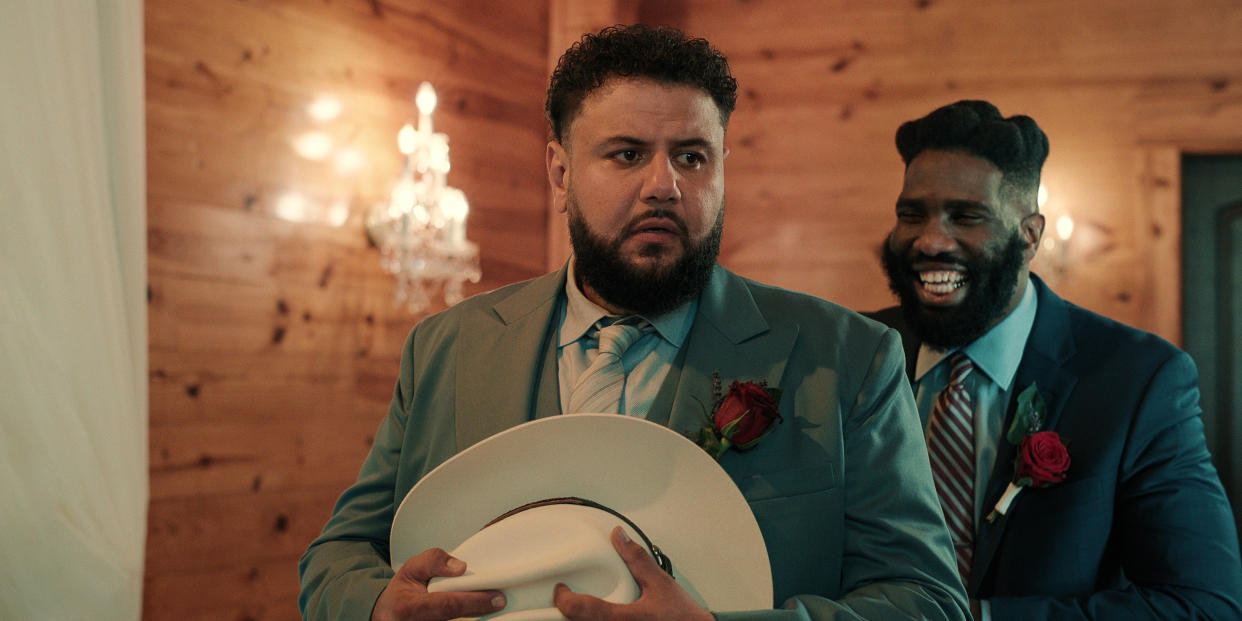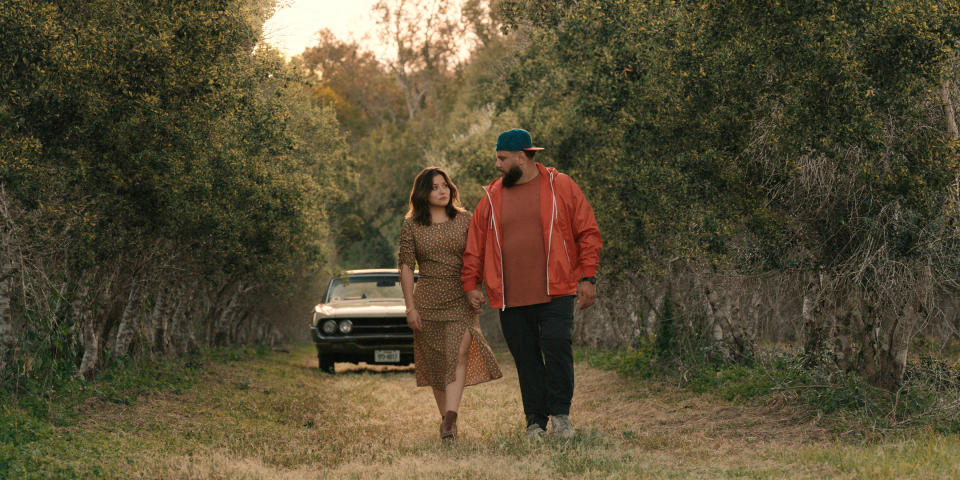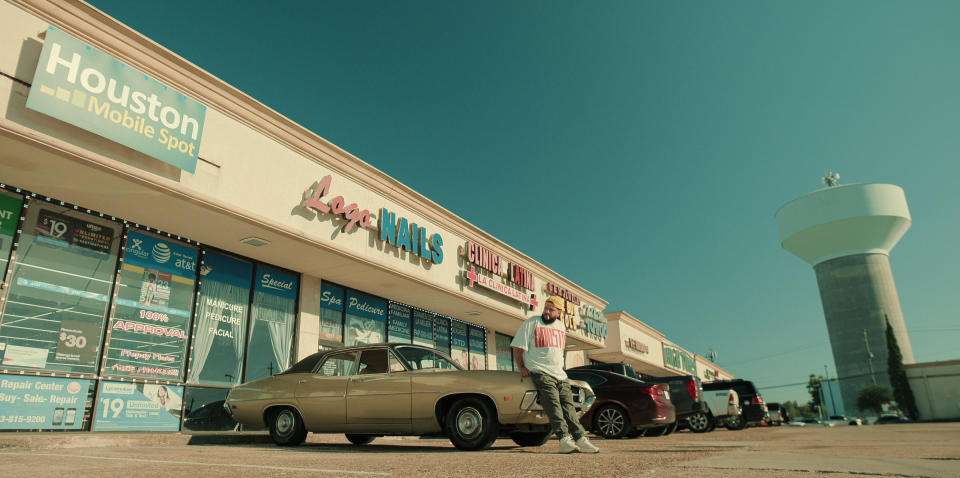How ‘Mo’ Brings the Spaghetti Western to Modern Houston

Mo Amer begins the Netflix series “Mo” with some autobiographical facts about his life and family: Palestinian refugees living in Houston, waiting on the U.S. immigration system to, first, make sense and, second, grant them status, while having to make a living in the meanwhile. The show that follows looks the way that life often feels. Moments of romance are drenched in the warmth of a sunset, plans to get ahead flow in montage, and crisis can come out of nowhere like a hard cut.
The Netflix series can turn on a dime from lightning-fast comedy to the joy of culture and belonging to crushing heartbreak. But this kind of heightened comedy with real, complex emotion at its heart can be hard to manage. On this episode of the Filmmaker Toolkit podcast, showrunner Mo Amer discusses how he and his team built a series that’s able to juggle its tonal ambitions, how they built the show’s hip and absurd sense of humor, and how they made filmmaking choices that spotlight the city (Houston) and the culture (the Palestinian diaspora) at the show’s heart.
More from IndieWire
Listen to the full episode below, or read on for excerpts from our interview.
You can listen to the full discussion above, or via subscribing to the Toolkit podcast via Apple Podcasts, Pocket Casts, Spotify, or Overcast.
Partial Transcript Below
Amer on the Process of Fictionalizing His Experiences
We had to start out with what the grounded reality is, what the truth is and making sure that [the series is] grounded in this real experience that is my life. And not only mine, but my mothers, my family’s — the displacement, the statelessness, and what does that mean? Defining that and getting deeper and deeper and into the emotional side effects that comes with such an experience, you start diving into very personal topics and it kept going back to my father. It felt like, you know, it’s such an enormous thing to experience as a 14-year-old kid: losing a parent, aside from being displaced by war, and losing everything and starting over. What is the thing that really took it over the edge?
The emotionality of my experience, not having enough time with my father was a steady part of our discussion. So once we got into the nitty gritty of immigration, asylum, my deeply personal stories, we just were thinking of how we can continue to layer the characters and add to them. And, you know, one of them was Lean. Like, if he went through a traumatic experience today, which he does at the end of Episode 1, then he has access to something like Lean, it shows like how easily accessible drugs are, number one, in America. What are the spiritual consequences of that? What does that do to a person, and suppressing your emotions, what could that do as well?
[The process] was just constantly diving in and asking question that scared me, diving in and asking questions, the what ifs, right? The, ‘If I never found stand-up comedy’ — then what would you do now? What if you were still working under the table and unable to provide for your family and feel less than in a relationship that you’re in, where your girlfriend has all the opportunities that she’s worked really hard for and has the ability to work legally and to accomplish something?’ And then also like, it is kind of crazy, the immigration aslyee process essentially forces you into a life that’s criminally adjacent, you know, that’s not legal above water, almost challenging you to go down this road. And it’s so interesting to dig deep into that and see what we can get out of it.

Courtesy of Netflix
Amer on the Look of the Series
Cinematically, with the flashbacks in particular, I wanted them to be grainy. I wanted them to feel like they’re on film. I wanted them to have this texture to them. I love oners, you know, I really love having moving shots where it doesn’t feel so still all the time and that’s something that we did very successfully in the flashbacks, all the way around. I really love that. Because [Director Slick Naim] asked me, he was like, ‘Man, you’ve had this in your head for eight years. How do you see this?’ And that’s what makes him such a great director and a wonderful collaborator, truly like [we had a] great dialogue of how we want to execute this.
Whenever I was interviewing directors and DPs, I would describe [the show as] an urban Western, [with] Houston as our landscape. I love these like Spaghetti Western shots and then the fact that we had an olive tree storyline, where we get to be on a farm, was so fun to get those Spaghetti Western shots with that strong Houston sun beaming down on those rich Gulf clouds. Like I was just so excited to the point where they became the title cards in the series — the clouds, you know? [It became] such a great metaphor. Like where is [Mo]? You know, he’s in the clouds. It’s this interesting thing to play with. I definitely wanted Houston to feel like another character in the show.

Courtesy of Netflix
Amer on How Music Informs the Show’s Rhythm and Tone
Music definitely informed a lot of the pacing for me, where it was just like, okay, who am I musically? Like, what do I listen to? Well, I’m definitely hip-hop. I’m definitely a little bit R&B. I’m a little bit chopped up, screwed up music. I’m Palestinian folk music. I love the stories in country. Like I’m a little bit country. I’m a little bit bluegrass, little bit of jazz, little bit of waltz. And that’s something that really informed the pacing and the subject matter. Like, in Episode 4, I think it really stands out to me where you have Maria and Mo having completely different experiences where Mo is in a pickle with Dante and she’s at this $6 million mansion. I was like, ‘Ah, man, this is like a little dance, a little shuffle. And when I was sitting with Common in the studio in New York with all these incredible musicians and Kareem, and I was like, ‘Can we just play a waltz? Can the band just play a waltz to this and see how we can balance that out?’
And it was just so much fun to do that. And at the end of it, [Mo’s] having this romantic moment with his girlfriend, which the song came up organically when [Teresa Ruiz, who plays Maria] and I were hanging out and [I was] showing her Houston and we’re bonding to build our onscreen relationship and our own personal relationship. And she played this song and I found it so emotional and also funny with that tuba, like it was just a beautiful, folksy Tejano sound that is so romantic and pleasant. And and I just thought like, ‘Oh, I’ll surprise Teresa with it at the end of [the episode]’ because it hit me so hard and yeah, there’s just like a perfect encapsulation of what the show is.
Then in Episode 2, where the song ‘‘Yamo’, which is from a classic TV show — I’ve only seen my father cry on two occasions: when my mom’s mom passed away and then when he was watching that particular episode and that scene came up and the family was all around. I was like 5 or 6 years old and I was seeing everybody crying. It was so powerful. And then I watched it again as a teenager and I started crying. And then to have it in an American series, this many years later, and to get a letter from the creator of that show, who’s in his mid-80s in war-torn Syria, [to send me] a letter with my name on it saying ‘I give Mohammad Amer permission to use it in his Netflix series’ was deeply emotional, impactful and a full circle moment, for sure.
The Filmmaker Toolkit podcast is available on Apple Podcasts, Spotify, Overcast, and Stitcher.
Best of IndieWire
7 New Netflix Shows in September 2022 — and the Best Reasons to Watch
‘The Lord of the Rings’: Everything You Need to Know About Amazon’s Big Money Adaptation
Sign up for Indiewire's Newsletter. For the latest news, follow us on Facebook, Twitter, and Instagram.

 Yahoo News
Yahoo News 
